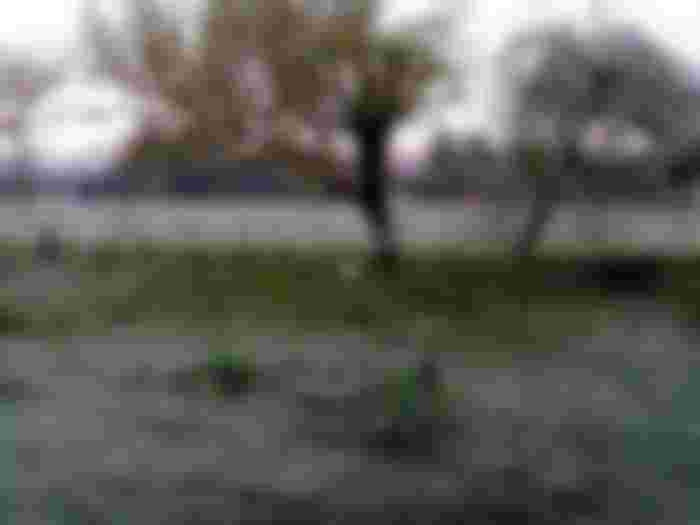If you are growing fruits and vegetables in temperate climates, you certainly have had to deal with the issue of frost. But what causes frost, exactly? How can you mitigate frost related damage?
Space is cold
Let's start with an explanation about why the soil freezes. Basically, it is because outer space is very cold, and warm object radiate their heat away.
Every piece of matter that is above absolute zero radiates heat away. That cannot be avoided. Particles oscillate and emit electromagnetic radiation away. The only reason a body does not perpetually cool down is because it is surrounded with other bodies, particles, that radiate heat back towards it or warm it through conduction. Conduction is basically particles bumping into each others, and if one body being in contact with another is warmer than the other, there will statistically be more energy going towards the other body, than there is energy coming back from it.
So our problem is that space is cold. It does not radiate much heat back, and does not reflect back towards us any of the heat we radiate towards it.
Our heat sources: the sun and the earth
Only the small portion of space that is the sun radiates a significant amount energy towards us. The only other major source of heat at our disposal, other than the sun, is the earth itself. It accumulated a lot of mechanical energy back when all the rocks collided together, and nowadays it still radiates some of that heat. But the main way the earth is producing heat is through radioactive decay of particles. The geothermal heat reaching the surface of the planet from below is however much lower than the solar heat reaching the surface from above. The total heat originating from the planet amounts to only 0.025 %, while the heat received from the sun amounts to 99.97% of the total.
So during summer time, the risk of frost is very low. Heat is accumulated during the day in the entire system: earth, ocean and atmosphere. In the winter, on the other hand, frost is a lot more likely as the sun does not radiate as much energy per square meter of earth in that particular hemisphere, due to a higher angle of incidence of the light rays reaching the soil.

Water phase-change
So, why doesn't it freeze every night? It may be because the soil, air and vegetation accumulated enough heat during the day so that it doesn't have time to cool down to below 0°C before the sun shows up again. It is also important to understand that 0°C is a threshold that isn't easy to cross when you are surrounded with water, and your own body is mostly made off water. When water reaches 0°C, it stops decreasing in temperature for a while, until all of it is frozen. The continuing drop in thermal energy goes into the phase-change process, from liquid water into ice, before it can again make the temperature drop any further.
Many plants can survive a minor freeze, because their internal water is in a state that has a lower freezing temperature. It effectively contains anti-freezing fluid. So surrounding water that freezes at 0°C makes a strong buffer preventing internal plant water to freeze. If the temperature goes down enough to make water freeze inside the plant's cells, the cells are usually destroyed.
Greenhouse effect
Then, there is the famous greenhouse effect. In a greenhouse made of transparent materials, most electromagnetic waves are able to shine through the material. Some of that radiation is reflected with the same wavelength as it arrived, and leaves the greenhouse. But most most of the radiation is absorbed into vegetation and into the earth. Most of these solid materials don't radiate light back in the visible spectrum, except for some phosphorescent materials. They do however radiate energy in the infrared spectrum. And it turns out the transparent materials reflect those wavelengths. So the radiation bounces back and forth, and keeps heating the soil and vegetation on the way back. Atmospheric greenhouse effect works the same way, except that it is carbon dioxide, methane, water particles… that reflect the infrared heat back towards the earth.
Cloud albedo
Another reason heat is reflected back towards the soil is because of cloud cover. Clouds act similar to greenhouse gasses, except that they reflect both visible and infrared light. So they don't let all the visible light touch the earth during daytime, but they also don't let all of the infrared light radiate into outer space during night time. That's why you don't see frost very often when the sky is clouded during night time.
Frost mitigation
Using all of that knowledge, we can now figure out some ways to mitigate frost related damage.
Somewhere in the coldest valley of the Austrian Alps, a famous farmer is cultivating cherries and some citrus trees, up in the mountains, at an elevation of 1100 to 1500 meters above sea level. The way he manages to do this is by using a series of large ponds, wetlands and water gardens that act as a thermal mass. Water accumulates heat during the day, and releases it during the night.
Another way to mitigate frost damage is to spray-mist water directly on the plants that you want to protect. This is done in orchards, during the spring, when there is an unusual late season frost. This keeps flowers at 0°C, and can save that year's harvest.
Another way you can protect your plants during night time is to place an anti-frost veil protection above your plants. This helps retain some of the heat that would otherwise be radiated directly into outer space.
You can also plant frost-sensitive plant underneath a larger tree, which will also prevent all that heat to radiate away. Evergreen tree would work best, but I've witnessed frost-protecting effects on my land even underneath trees that had not yet leafed out.



Nice post